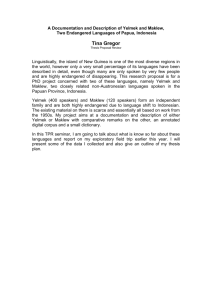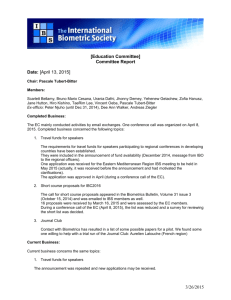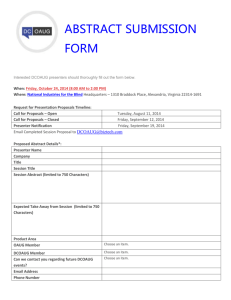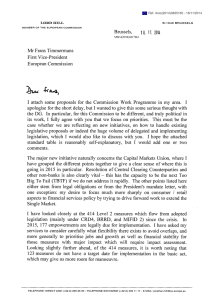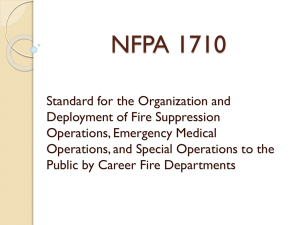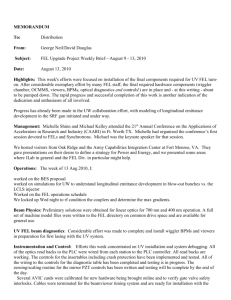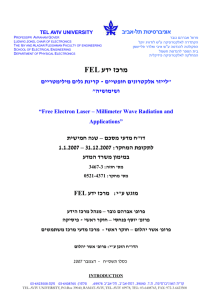the Guidance notes - Foundation For Endangered Languages
advertisement
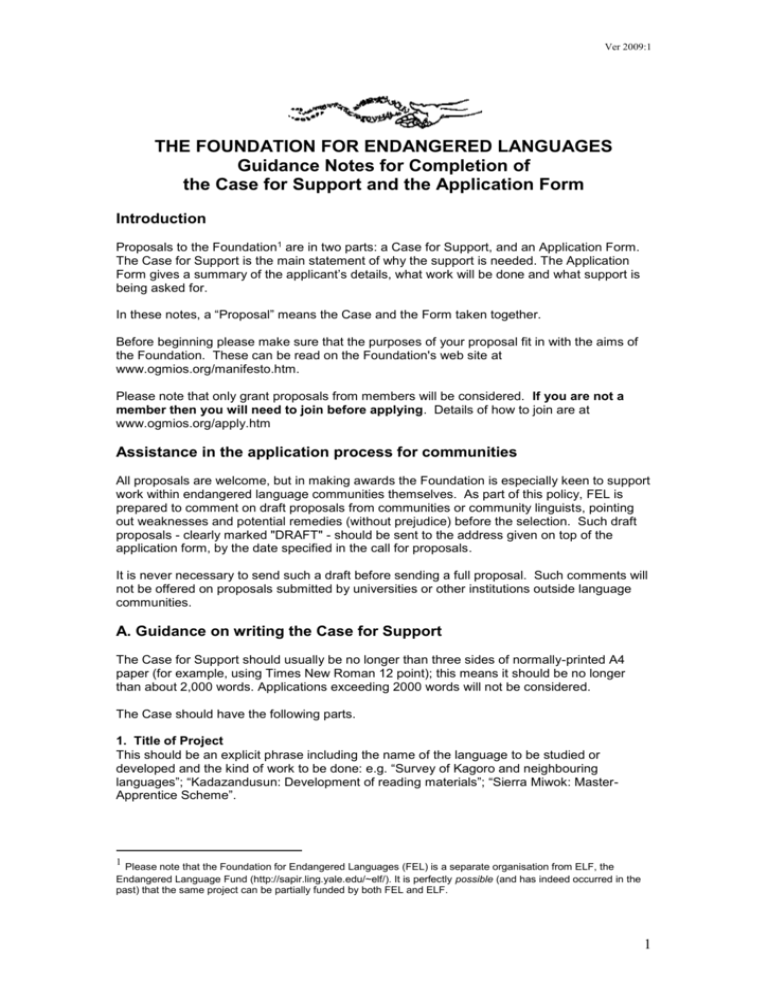
Ver 2009:1 THE FOUNDATION FOR ENDANGERED LANGUAGES Guidance Notes for Completion of the Case for Support and the Application Form Introduction Proposals to the Foundation1 are in two parts: a Case for Support, and an Application Form. The Case for Support is the main statement of why the support is needed. The Application Form gives a summary of the applicant’s details, what work will be done and what support is being asked for. In these notes, a “Proposal” means the Case and the Form taken together. Before beginning please make sure that the purposes of your proposal fit in with the aims of the Foundation. These can be read on the Foundation's web site at www.ogmios.org/manifesto.htm. Please note that only grant proposals from members will be considered. If you are not a member then you will need to join before applying. Details of how to join are at www.ogmios.org/apply.htm Assistance in the application process for communities All proposals are welcome, but in making awards the Foundation is especially keen to support work within endangered language communities themselves. As part of this policy, FEL is prepared to comment on draft proposals from communities or community linguists, pointing out weaknesses and potential remedies (without prejudice) before the selection. Such draft proposals - clearly marked "DRAFT" - should be sent to the address given on top of the application form, by the date specified in the call for proposals. It is never necessary to send such a draft before sending a full proposal. Such comments will not be offered on proposals submitted by universities or other institutions outside language communities. A. Guidance on writing the Case for Support The Case for Support should usually be no longer than three sides of normally-printed A4 paper (for example, using Times New Roman 12 point); this means it should be no longer than about 2,000 words. Applications exceeding 2000 words will not be considered. The Case should have the following parts. 1. Title of Project This should be an explicit phrase including the name of the language to be studied or developed and the kind of work to be done: e.g. “Survey of Kagoro and neighbouring languages”; “Kadazandusun: Development of reading materials”; “Sierra Miwok: MasterApprentice Scheme”. 1 Please note that the Foundation for Endangered Languages (FEL) is a separate organisation from ELF, the Endangered Language Fund (http://sapir.ling.yale.edu/~elf/). It is perfectly possible (and has indeed occurred in the past) that the same project can be partially funded by both FEL and ELF. 1 Ver 2009:1 2. Background to the work Describe the language: its nature, location, number of speakers, relation to other languages, etc. You should include such details as adjacent languages (genetically and geographically) the number of known first language speakers, the number of known second language speakers, whether or not the language is being passed on to younger generations and, if so, by what means. You should state whether the language’s speakers view it as a distinct language or as a dialect of some other language. You should indicate what languages of communication are used with neighbouring communities and whether this communication in other languages is general, or limited to certain spheres of activity. You should describe previous research stating whether the language has been documented previously (if so please attach a bibliography in a separate sheet). You should describe the current sphere and range of use of the language (for example mass media, religious/ceremonial use, spoken communication etc). You should describe the nature of the threat to the language and the process of language diminution or loss as far as is known, with statistical evidence if possible. 3. The work Describe the work for which you are seeking support. Set out the aims and objectives and how you intend to achieve these. Describe the methods to be used. 4. Expected outcomes and beneficiaries Describe what you hope will come from the work. What outcomes do you hope for? What material will be produced? How will the results be used, who will use them and for what purpose? 5. Collaboration Please describe who you intend to collaborate with and how? 6. Resources Please justify the resources you have asked for on the form. Please state clearly how were the sums requested were calculated and if are any additional sources of funding for this project? 7. Qualifications Briefly describe your working background and academic qualifications as an indication of why you are suitable to carry out this work. 2 Ver 2009:1 B. Guidance on completing the application form The following paragraphs describe what is expected under each of the headings in the Application Form. The numbering follows the numbering on the form. 1. Applicant details Please give your full name, the institution and department you work for, or are affiliated to, and the address for correspondence. If this address is different from the organisation address, please give the organisation's address on a separate sheet with an explanation of why the addresses are different. Please also give any other contact details such as your phone, fax and e-mail where available. 2. Title of Project Please state the title of the project. This should be the same as in the Case for Support. 3. Target language and location State clearly the language to be studied and its geographical location (country, region, etc) 4. Objectives Please list the objectives of the project in order of their priority. No explanation need be given here -- we are looking for the main points. 5. Overview Please summarise the aims, and likely outcomes of the work IN TERMS THAT A GENERAL AUDIENCE CAN UNDERSTAND. This is different from the Summary in the Case for Support, since (if your project is funded) it will be used to describe your project to the public. The Foundation is a charity funded by membership subscription and donations. We need to explain the nature of the work we support to potential donors. The information you supply here will help us to do that. 6. Resources List the resources for which you are requesting support. State clearly the currency being used. 7. Collaboration with local communities Please describe briefly the collaborations you propose with local communities naming the groups with whom you are collaborating. 8. Support from other organisations We would like to know how the work you are proposing fits into other work being done by yourself, or close colleagues. We would also like to know where our support would be additional to support you already have, so please state clearly what other support is available for the work, and why additional resources are requested from FEL. 9. Declaration As the wording of the declaration states, the Foundation is a charity and must be able to prove the work it supports is of public benefit. The declaration also requires you to provide the Foundation with a list of recommendations for further monitoring and work on the language that is the subject of the application. This material will serve both to support the current application in the selection process, and also to provide the Foundation with arguments in their quest for further funds to supplement existing projects in the future. 3

